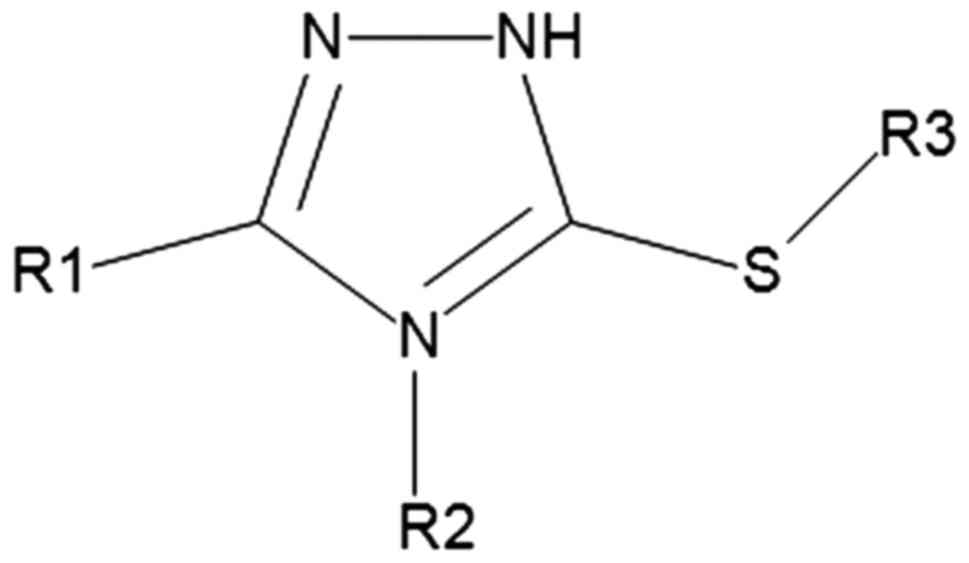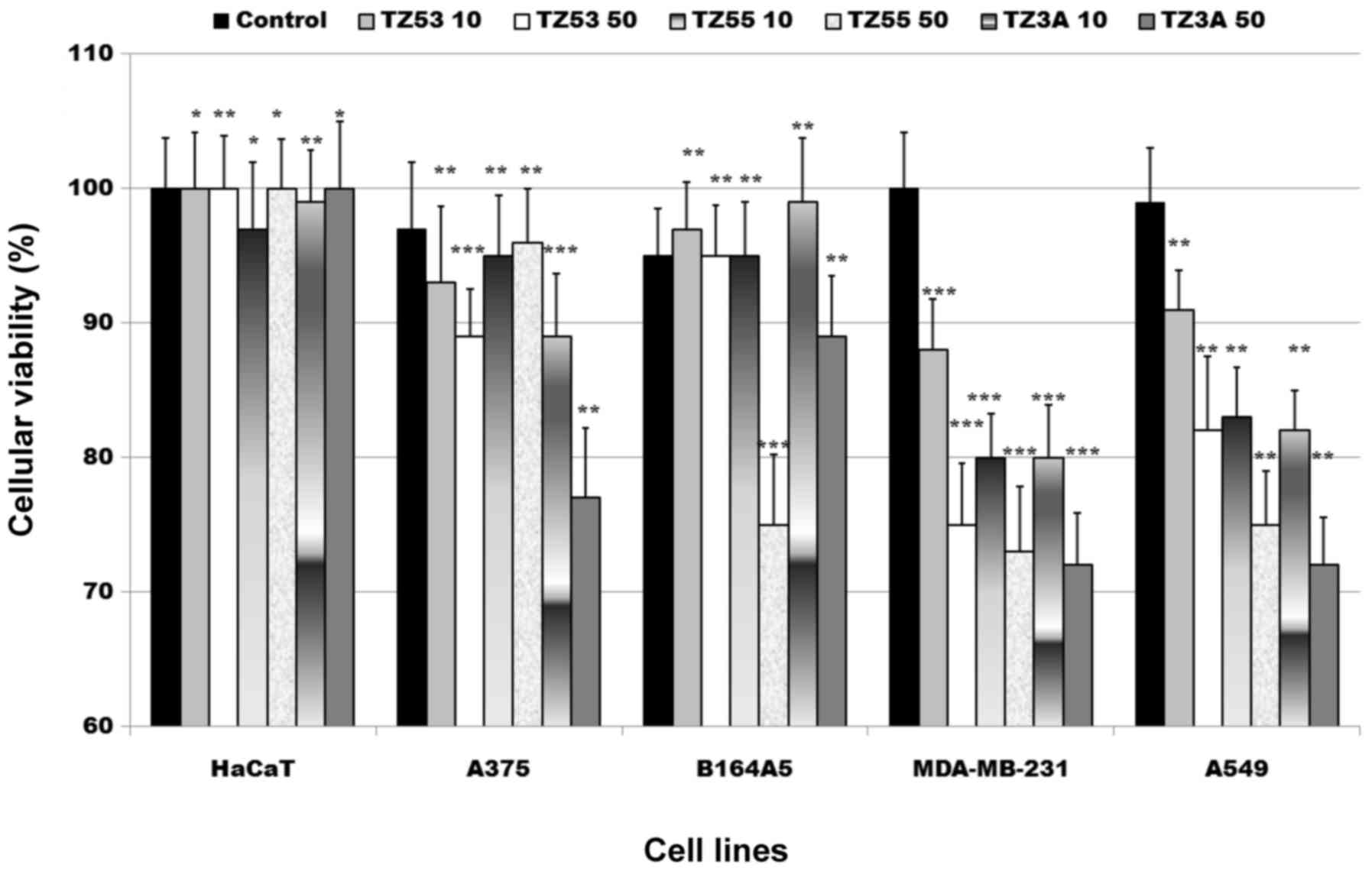|
1
|
Chinthala Y, Thakur S, Tirunagari S,
Chinde S, Domatti AK, Arigari NK, K V N S S, Alam S, Jonnala KK,
Khan F, et al: Synthesis, docking and ADMET studies of novel
chalcone triazoles for anti-cancer and anti-diabetic activity. Eur
J Med Chem. 93:564–573. 2015. View Article : Google Scholar : PubMed/NCBI
|
|
2
|
Palumbo MO, Kavan P, Miller WH Jr, Panasci
L, Assouline S, Johnson N, Cohen V, Patenaude F, Pollak M, Jagoe
RT, et al: Systemic cancer therapy: achievements and challenges
that lie ahead. Front Pharmacol. 4:572013. View Article : Google Scholar : PubMed/NCBI
|
|
3
|
Zugazagoitia J, Guedes C, Ponce S, Ferrer
I, Molina-Pinelo S and Paz-Ares L: Current Challenges in Cancer
Treatment. Clin Ther. 38:1551–1566. 2016. View Article : Google Scholar : PubMed/NCBI
|
|
4
|
Wu P, Nielsen TE and Clausen MH:
FDA-approved small-molecule kinase inhibitors. Trends Pharmacol
Sci. 36:422–439. 2015. View Article : Google Scholar : PubMed/NCBI
|
|
5
|
Han F, Lin S, Liu P, Tao J, Yi C and Xu H:
Synthesis and structure-activity relationships of I3K//mTOR dual
inhibitors from a series of 2-amino-4-methylpyrido[2,3-d]pyrimidine
derivatives. Bioorg Med Chem Lett. 24:4538–4541. 2014. View Article : Google Scholar : PubMed/NCBI
|
|
6
|
Zhao HF, Wang J and Tony To SS: The
phosphatidylinositol 3-kinase/Akt and c-Jun N-terminal kinase
signaling in cancer: Alliance or contradiction? (Review). Int J
Oncol. 47:429–436. 2015.PubMed/NCBI
|
|
7
|
Hollande F, Pannequin J and Joubert D: The
long road to colorectal cancer therapy: Searching for the right
signals. Drug Resist Updat. 13:44–56. 2010. View Article : Google Scholar : PubMed/NCBI
|
|
8
|
Toren P and Zoubeidi A: Targeting the
I3K/Akt pathway in prostate cancer: Challenges and opportunities
(Review). Int J Oncol. 45:1793–1801. 2014.PubMed/NCBI
|
|
9
|
Sahu JK, Ganguly S and Kaushik A:
Triazoles: A valuable insight into recent developments and
biological activities. Chin J Nat Med. 11:456–465. 2013.PubMed/NCBI
|
|
10
|
Olah M, Rad R, Ostopovici L, Bora A,
Hadaruga N, Hadaruga D, Moldovan R, Fulias A, Mractc M and Oprea
TI: WOMBAT and WOMBAT-PK: bioactivity databases for lead and drug
discovery. Chemical biology: from small molecules to systems
biology and drug design. Schreiber SL, Kapoor TM and Wess G: 1–3.
Wiley-VCH Verlag GmbH; Weinheim: pp. 760–786. 2008, View Article : Google Scholar
|
|
11
|
Li X, Li XQ, Liu HM, Zhou XZ and Shao ZH:
Synthesis and evaluation of antitumor activities of novel chiral
1,2,4-triazole Schiff bases bearing γ-butenolide moiety. Org Med
Chem Lett. 2:262012. View Article : Google Scholar
|
|
12
|
Chowrasia D, Karthikeyan C, Choure L,
Sahabjada S, Gupta M, Arshad Md and Trivedi P: Synthesis,
characterization and anti cancer activity of some fluorinated
3,6-diaryl-[1,2,4] triazolo[3,4-b][1,3,4]thiadiazoles. Arab J Chem.
6–10. 2013.
|
|
13
|
Chand P, Chesney JA, Clem BF, Tapolsky GH,
Telang S and Trent JO: Small-Molecule Choline Kinase Inhibitors As
Anti-Cancer Therapeutics. Patent US 2011/0257211 A1
|
|
14
|
Hou YP, Sun J, Pang ZH, Lv PC, Li DD, Yan
L, Zhang HJ, Zheng EX, Zhao J and Zhu HL: Synthesis and antitumor
activity of 1,2,4-triazoles having 1,4-benzodioxan fragment as a
novel class of potent methionine aminopeptidase type II inhibitors.
Bioorg Med Chem. 19:5948–5954. 2011. View Article : Google Scholar : PubMed/NCBI
|
|
15
|
Georgiyants V, Perekhoda L, Saidov N and
Kadamov I: Docking studies and biological evaluation of anti-cancer
activity of new 1,2,4-triazole (4h) derivatives. Scr Sci Pharm.
1:46–53. 2014.
|
|
16
|
Holla BS, Sarojini BK, Rao BS, Akberali
PM, Kumari NS and Shetty V: Synthesis of some halogen-containing
1,2,4-triazolo-1,3,4-thiadiazines and their antibacterial and
anticancer screening studies - part I. Farmaco. 56:565–570. 2001.
View Article : Google Scholar : PubMed/NCBI
|
|
17
|
Gupta D and Jain DK: Synthesis, antifungal
and antibacterial activity of novel 1,2,4-triazole derivatives. J
Adv Pharm Technol Res. 6:141–146. 2015. View Article : Google Scholar : PubMed/NCBI
|
|
18
|
Hawkins PCD, Skillman AG, Warren GL,
Ellingson BA and Stahl MT: Conformer generation with OMEGA:
Algorithm and validation using high quality structures from the
Protein Databank and Cambridge Structural Database. J Chem Inf
Model. 50:572–584. 2010. View Article : Google Scholar : PubMed/NCBI
|
|
19
|
McGann M: FRED and HYBRID docking
performance on standardized datasets. J Comput Aided Mol Des.
26:897–906. 2012. View Article : Google Scholar : PubMed/NCBI
|
|
20
|
Berman HM, Westbrook J, Feng Z, Gilliland
G, Bhat TN, Weissig H, Shindyalov IN and Bourne PE: The protein
data bank. Nucleic Acids Res. 28:235–242. 2000. View Article : Google Scholar
|
|
21
|
Gurusaran M, Shankar M, Nagarajan R,
Helliwell JR and Sekar K: Do we see what we should see? Describing
non-covalent interactions in protein structures including
precision. IUCrJ. 1:74–81. 2013. View Article : Google Scholar
|
|
22
|
Bercean VN, Badea V, Sisu E, Bindila L and
Csunderlik C: A simplified method of obtaining
3-aryl-5-mercapto-1,2,4-triazoles. Rev Chim. 54:368–369. 2003.
|
|
23
|
Soica C, Oprean C, Borcan F, Danciu C,
Trandafirescu C, Coricovac D, Crăiniceanu Z, Dehelean CA and
Munteanu M: The synergistic biologic activity of oleanolic and
ursolic acids in complex with hydroxypropyl-γ-cyclodextrin.
Molecules. 19:4924–4940. 2014. View Article : Google Scholar : PubMed/NCBI
|
|
24
|
Nadeem H, Mohsin M, Afzaal H, Riaz S,
Zahid A and Muhammad SA: Synthesis and in Vitro Biological
Activities of 4,5-Disubstituted 1,2,4-Triazole-3-Thiols. Adv
Microbiol. 3:366–375. 2013. View Article : Google Scholar
|
|
25
|
El-Sayed WA, Flefel EM and Morsy EMH:
Anticancer and antimicrobial activities of some synthesized
pyrazole and triazole derivatives. Pharmachem. 4:23–32. 2012.
|
|
26
|
Cheng T, Li Q, Zhou Z, Wang Y and Bryant
SH: Structure-based virtual screening for drug discovery: A
problem-centric review. AAPS J. 14:133–141. 2012. View Article : Google Scholar : PubMed/NCBI
|
|
27
|
Ferreira LG, dos Santos RN, Oliva G and
Andricopulo AD: Molecular Docking and Structure-Based Drug Design
Strategies. Molecules. 20:13384–13421. 2015. View Article : Google Scholar : PubMed/NCBI
|
|
28
|
Oda A, Saijo K, Ishioka C, Narita K, Katoh
T, Watanabe Y, Fukuyoshi S and Takahashi O: Predicting the
structures of complexes between phosphoinositide 3-kinase (PI3K)
and romidepsin-related compounds for the drug design of
PI3K/histone deacetylase dual inhibitors using computational
docking and the ligand-based drug design approach. J Mol Graph
Model. 54:46–53. 2014. View Article : Google Scholar : PubMed/NCBI
|
|
29
|
Saini KS, Loi S, de Azambuja E,
Metzger-Filho O, Saini ML, Ignatiadis M, Dancey JE and
Piccart-Gebhart MJ: Targeting the PI3K/AKT/mTOR and Raf/MEK/ERK
pathways in the treatment of breast cancer. Cancer Treat Rev.
39:935–946. 2013. View Article : Google Scholar : PubMed/NCBI
|
|
30
|
Nitulescu GM, Margina D, Juzenas P, Peng
Q, Olaru OT, Saloustros E, Fenga C, Spandidos DA, Libra M and
Tsatsakis AM: Akt inhibitors in cancer treatment: The long journey
from drug discovery to clinical use (Review). Int J Oncol.
48:869–885. 2016.
|
|
31
|
Häggblad Sahlberg S, Mortensen AC, Haglöf
J, Engskog MK, Arvidsson T, Pettersson C, Glimelius B, Stenerlöw B
and Nestor M: Different functions of AKT1 and AKT2 in molecular
pathways, cell migration and metabolism in colon cancer cells. Int
J Oncol. 50:5–14. 2017.
|
|
32
|
Vignot S, Faivre S, Aguirre D and Raymond
E: mTOR-targeted therapy of cancer with rapamycin derivatives. Ann
Oncol. 16:525–537. 2005. View Article : Google Scholar : PubMed/NCBI
|
|
33
|
Fyffe C and Falasca M:
3-Phosphoinositide-dependent protein kinase-1 as an emerging target
in the management of breast cancer. Cancer Manag Res. 5:271–280.
2013.PubMed/NCBI
|
|
34
|
Cathomas G: PIK3CA in Colorectal Cancer.
Front Oncol. 4:352014. View Article : Google Scholar : PubMed/NCBI
|
|
35
|
Moon G, Lee SE, Oh MM, Lee SC, Jeong SJ,
Hong SK, Yoon CY, Byun SS, Park HS and Cheon J: NVP-BEZ235, a dual
PI3K/mTOR inhibitor synergistically potentiates the antitumor
effects of cisplatin in bladder cancer cells. Int J Oncol.
45:1027–1035. 2014.
|
|
36
|
Gong HC, Wang S, Mayer G, Chen G, Leesman
G, Singh S and Beer DG: Signatures of drug sensitivity in nonsmall
cell lung cancer. Int J Proteomics. 2011:2154962011. View Article : Google Scholar : PubMed/NCBI
|
|
37
|
Yi YW, Hong W, Kang HJ, Kim HJ, Zhao W,
Wang A, Seong YS and Bae I: Inhibition of the PI3K/AKT pathway
potentiates cytotoxicity of EGFR kinase inhibitors in
triple-negative breast cancer cells. J Cell Mol Med. 17:648–656.
2013. View Article : Google Scholar : PubMed/NCBI
|
|
38
|
Jia T, Zhang L, Duan Y, Zhang M, Wang G,
Zhang J and Zhao Z: The differential susceptibilities of MCF-7 and
MDA-MB-231 cells to the cytotoxic effects of curcumin are
associated with the PI3K/Akt-SKP2-Cip/Kips pathway. Cancer Cell
Int. 14:1262014. View Article : Google Scholar : PubMed/NCBI
|
|
39
|
Kwei KA, Baker JB and Pelham RJ:
Modulators of sensitivity and resistance to inhibition of PI3K
identified in a pharmacogenomic screen of the NCI-60 human tumor
cell line collection. PLoS One. 7:e465182012. View Article : Google Scholar : PubMed/NCBI
|
|
40
|
Liu H, Scholz C, Zang C, Schefe JH, Habbel
P, Regierer AC, Schulz CO, Possinger K and Eucker J: Metformin and
the mTOR inhibitor everolimus (RAD001) sensitize breast cancer
cells to the cytotoxic effect of chemotherapeutic drugs in vitro.
Anticancer Res. 32:1627–1637. 2012.PubMed/NCBI
|
|
41
|
Liu KKC, Zhu J, Smith GL, Yin MJ, Bailey
S, Chen JH, Hu Q, Huang Q, Li C, Li QJ, et al: Highly Selective and
Potent Thiophenes as PI3K Inhibitors with Oral Antitumor Activity.
ACS Med Chem Lett. 2:809–813. 2011. View Article : Google Scholar : PubMed/NCBI
|















